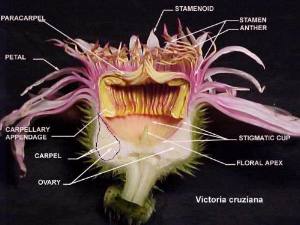
|
Victoria Seeds |
|
Before attempting to produce and collect seeds from Victoria, it's important to understand how the flower is constructed and which parts do what. More details. The stigmatic cup and the ovaries below it are the "female" parts of the flower. The stigma receives pollen and allows pollen tubes to penetrate it. These tubes reach the ovules below and fertilize the future seeds. The stamens contain the anthers, which produce pollen, the "male" part of the flower. More details.
It is also important to understand the time frame and the terms we use to describe it. The "first night" is the first night the flower opens. We call the morning between the first night and second night opening the "second morning" and the morning after the second night the "third morning". The stigmatic cup is receptive to fertilization by pollen continuously from a few hours before the first night the flower opens until the flower sinks into the water. This includes the third morning if the flower is prevented from sinking. Pollen is only produced the second night but can be stored (see below).
In self-pollination, pollen from the second night flower lands on the stigmatic cup and seed set is achieved. In cultivation, we have seen no evidence of insect intervention in this process. Higher potential seed numbers can be assured by "helping" the self-pollination by rubbing pollen vigorously onto the stigmatic surface. In good weather conditions, seed set without this help can be as high as with help.
We must mention here that it is not recommended to self-pollinate or collect seeds from any of the hybrids. They will produce mongrel offspring, inconsistent in their characteristics. For a detailed explanation of this, see Should I Grow From Seed? It is the species, V. amazonica and V. cruziana, that are valuable to self-pollinate and to cross-pollinate in order to produce the primary hybrids, V. 'Adventure' (V. amazonica as seed parent and V. cruziana as pollen parent) and V. 'Longwood Hybrid' (V. cruziana as seed parent and V. amazonica as pollen parent).
In order to achieve pure crosses, the seed parent flower must be "emasculated", removing the male parts, the anthers, before they produce any pollen. The simple way to do this is to remove what we call "The Ring", the upper part of the carpellary appendages, the paracarpels, the stamens, the stamenoids and the inner petals.
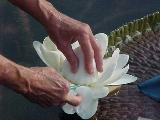
|
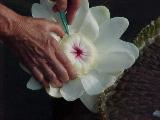
|
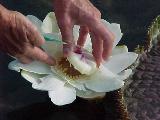
|
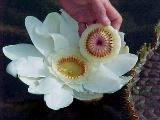
|
|
|
|
|
|
We remove enough inner petals to clearly see the base of the stamenoids. Using surgical scissors, a scalpel, or a long-bladed X-acto knife, we make a cut into the base of the stamenoids through the carpellary appendages. The angle of the cut is determined by which type of plant is involved. The paracarpels of amazonica angle toward the stigma so the angle of the cut must be steep. The paracarpels of cruziana are rather flat so the cut can be flat. We continue to cut around at the same level, lifting slightly as we go, and out pops the intact Ring. If any stamens are cut accidentally, they should be removed carefully from the remaining flower.
The Ring can be removed the first night or the second morning. After that ripe pollen can be present which would corrupt the cross. Pollen from the other parent flower can be introduced successfully any time from the first night through the third morning provided the stigma remains dry.
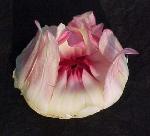 |
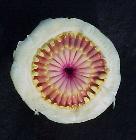 |
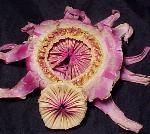 |
|
|
|
paracarples removed |
We prefer to do our ring removal and pollinations the second morning, as early as we can see. This has an added benefit in that the removed ring, if it is set aside in the shade at 80F or higher, WILL ripen its pollen by evening, allowing the morning's seed parent to become pollen parent for other flowers. This is NOT the case for rings removed the first night. The pollen will not ripen.
Rings that have ripened, as well as anthers with dehiscing pollen removed from second night flowers, can be stored, wrapped in non-acidic paper and placed in air-tight plastic bags, in the door of the refrigerator for many days. Viability drops somewhat with each day of storage.
After pollination, we tag the flower stems and close the flowers, wrapping them with cheesecloth. After a few days we remove the cheesecloth, to allow the remaining flower parts to rot off. The first sign of successful seed set is a "crook" or "S" in the stem. To follow the entire maturation and collecting process, see this page:
|
|
||
|
|
|
Articles |
|
|
|
|
|
|
|
|